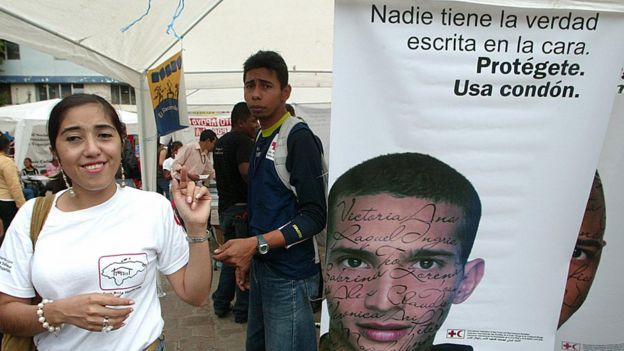Also available in: Español
Each year, about 2.5 million people are diagnosed with HIV worldwide; in Latin America, Argentina is by far the country with more new cases of infection.
This information was revealed by the latest large study on the spread of the virus, the Global Burden of Disease, conducted by the Institute for Health Metrics and Evaluation (IHME) of the University of Washington, USA.
The research analyzed the situation in 195 countries between 1980 and 2015 on the occasion of the 21st International AIDS Conference, held in South Africa from 18 to 22 July.
“The study shows that AIDS epidemic has not been overcome as yet and it that remains the biggest threat to global health of our time,” said Peter Piot, founding member of the executive committee of the Joint United Nations Programme on HIV/AIDS (UNAIDS).
Lack of protection

Image copyright GETTY IMAGES
“A level of new infections of over two million people each year represents a collective failure that requires strengthening of prevention policies and vaccine research,” Piot added.
Much was done in Latin America during the last decade to raise awareness on the use of preservatives to avoid infection.
Statistics reveal that the number of new infections has not changed much in the last decade: the yearly drop has been of 0.7% only between 2005 and 2015 (during the previous decade, this percentage was 2.7).
Moreover, cases in Argentina increased by 7.8% a year during that period, according to the report.
“The incidence of HIV in Argentina indicates that 14.4 people per 100,000 were infected in 2015,” the authors of the study said. Infections in that country are growing much faster than in any other country in the region.
The 5 countries in Latin America with more new HIV infections
Data: 2005-2015
-
Argentina
7.8% new cases per year.
-
Paraguay
4.9%
- Bolivia 4.8%
- Colombia 4.6%
- Ecuador 3.9%
Institute for Health Metrics and Evaluation (IHME), University of Washington, USA.
But, why so many new cases?
According to the scientists, the main cause of this increase in Argentina is due to unprotected sex: 9 out of 10 people diagnosed between 2012 and 2014 did not use preservatives.
And half of the cases involve heterosexual couples.

Image copyright THINKSTOCK “AIDS remains the biggest threat to global health of our time,” said Peter Piot, from UNAIDS.
After Argentina, the next country with more new HIV cases is Paraguay (4.9%), followed by Bolivia (4.8%), Colombia (4.6%) and Ecuador (3.9%).
Rounding out the list, with much more encouraging figures, are Peru (1.7%), Venezuela (0.4%), Uruguay (-0.5%) and Chile (-3.3%).
“An Alarming Picture”
In 2015, three-quarters of new infections (1.8 million) took place in sub-Saharan Africa. And from 2005 to 2015, 74 countries reached alarming quotas, particularly Indonesia, the Philippines and some countries of North Africa and Eastern Europe.
Despite years of good progress and decline of incidence globally, it was not the case across all regions, and access to antiretroviral therapy (ART) had much to do with it, experts say. However, the number of deaths did decrease, from 1.8 million in 2005 to 1.2 million in 2015, precisely thanks to that treatment.

Image copyright EPA – Access to antiretroviral treatment is essential, experts say.
“Our study shows an alarming picture of the slow progress in the decline of new HIV infections in the last 10 years,” said Haidong Wang, lead author of the research.
IHME director, Christopher Murray, spoke of “stagnation” in development aid for cases of HIV and AIDS “in many low-income countries.”
“A large scale-up will be needed by governments and international agencies to reach around US $36,000 million each year to end AIDS by 2030.”
Murray said it is important “to improve screening and treatment programs, and access to antiretroviral drugs.”
